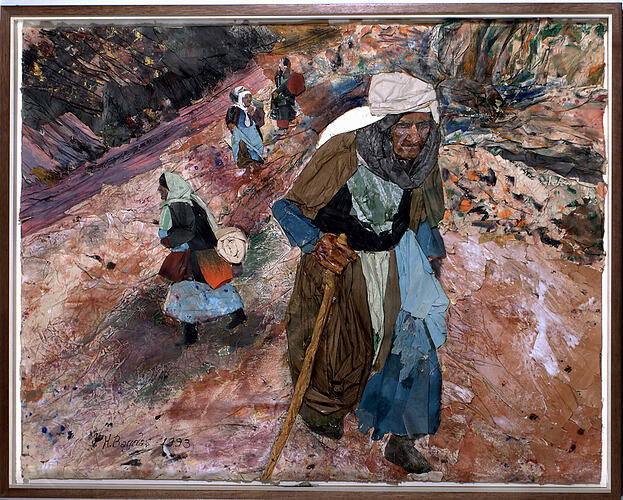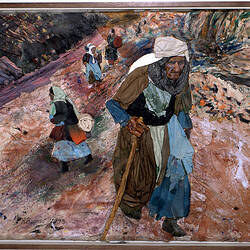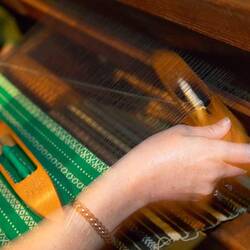Summary
Kurdish Refugees of the Gulf War by Hasan Bagdas, 1993. Hasan Bagdas is a Kurdish artist from Türkiye who arrived in Australia as a refugee in 1973 following severe oppression from the Turkish government. Hasan paints, amongst other subjects, political and social paintings which illustrate Kurdish life in Türkiye, Armenia and Iraq.
The Kurds are a diverse ethnic group whose struggle for independence has waged for centuries. In 2008 there were an estimated 22 million Kurds living in their homeland of Kurdistan, which encompasses parts of Türkiye, Iran, Iraq, Syria and Armenia. Political and ethnic divisions have prevented the Kurdish population from achieving unity and independence, so they remain minorities, frequently persecuted within the countries they live.
During the First Gulf War (Iran-Iraq War) the Kurdish Democratic Party (KDP) cooperated with Iran against Baghdad. Simultaneously Iraq was supporting the Iranian Kurds in their fight against Teheran. 150,000 Kurds or more were fighting with Baghdad against Iran and the KDP during the 1980s, and in 1988 the Iraqi Army crushed the alliance of Iranian and Kurdish KDP forces using any means available, including chemical weapons. About 5,000 civilians were killed by poison gas in March 1988 in the village of Halabja, only one of many such instances.
Description of Content
Artwork depicting plight of Kurdish refugees fleeing chemical warfare during the Gulf War. One woman dominates the foreground with stick in hand and three others can be glimpsed in the background, walking through a hostile arid landscape.
Physical Description
Paper collage and paint artwork. Paper has been folded and manipulated to create the figures and background. Oil paint has been used over the paper. Framed.
More Information
-
Collection Names
-
Collecting Areas
-
Acquisition Information
Donation from Mr Hasan Bagdas, 26 Jul 1996
-
Artist
Mr Hasan Bagdas, Preston, Greater Melbourne, Victoria, Australia, 1993
-
Place & Date Depicted
-
Format
Collage Artwork, Colour
-
Inscriptions
In black on lower left hand corner: H. Bagdas . 1993
-
Classification
-
Category
-
Discipline
-
Type of item
-
Overall Dimensions
122.5 cm (Length), 7 cm (Width), 95.5 cm (Height)
-
References
Peter Malanczuk (1991). 'The Kurdish Crisis and Allied Intervention in the Aftermath of the Second Gulf War.' EJIL, 2, pp.114-132 Barbara Robson (1996). 'Iraqi Kurds Their History and Culture', Refugee Fact Sheet Series No.13. Washington: Center for Applied Linguistics, The Refugee Service Center
-
Keywords
Artworks, Crafts, Cultural Identity, Cultural Traditions, Ethnic Groups, Kurdish Communities, Kurdish Immigration, Turkish Culture, Turkish Immigration, Visual Arts


